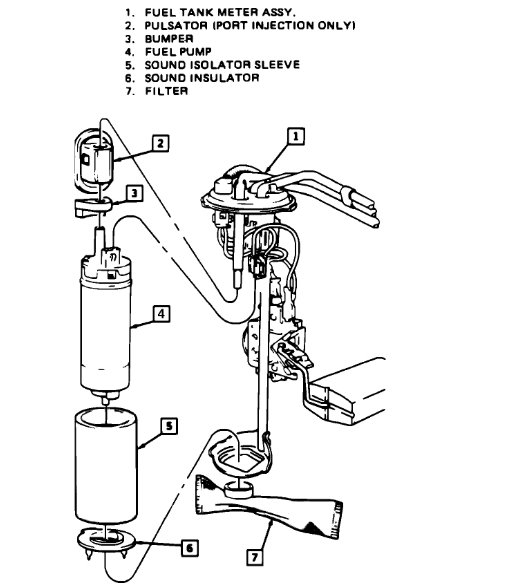41
CIRCUIT DESCRIPTION:
During cranking, the ignition module monitors the dual crank sensor sync signal. The sync signal is used to determine the correct cylinder pair to spark first. After the sync signal has been processed by the ignition module it sends a fuel control reference pulse to the PCM. When the PCM receives this pulse it will command all six injectors to open for a (priming) shot of fuel in all cylinders. After the priming, the injectors are left "OFF" for the next six fuel control reference pulses (two crankshaft revolutions) from the ignition module. This allows each cylinder a chance to use the fuel from the (priming) shot. During this waiting period, a cam pulse will have been received by the PCM. Now the PCM begins to operate the injectors sequentially, based on true camshaft position. However, if the cam signal is not present at start-up a code 41 will be set and the PCM will start sequential fuel delivery in any old random pattern. The engine has a 1 in 6 chance that fuel delivery is correct.
Code 41 sets when the following condition exists:
Cam sensor signal not received by by the PCM for 5 seconds while engine is running.
TEST DESCRIPTION
Code 41 Diagnostic Chart (Type I Ignition)
imageOpen In New TabZoom/Print
Numbers below refer to circled numbers on the diagnostic chart.
1. This step verifies proper operation of CKTs 633, 644, and 645.
2. Step validates the integrity of CKT 630 from C3I module to PCM.
3. If the camshaft gear magnet is interfacing with the cam sensor, the voltage reading will be zero. Bumping engine with the starter will rotate the magnet away from the sensor and the voltage reading should change to greater than 8 volts.
4. If the voltage reading of "BA12" is constantly varying and connection to the PCM is good, the PCM is faulty.
DIAGNOSTIC AIDS:
An intermittent may be caused by a poor connection, rubbed through wire insulation or a wire broken inside the insulation. Check For:
Poor Connection or a damaged Harness inspect PCM harness connectors for backed out terminal "BA12, " improper mating, broken locks, improperly formed or damaged terminals, poor terminal to wire connection and damaged harness.
Intermittent Test If connections and harness check OK, monitor a digital voltmeter connected from PCM terminal "BA12" to ground while moving related connectors and wiring harness. If the failure is induced, the voltage reading will change. This may help to isolate the location of the malfunction.
58 This may be the one. It is for the ignition lock cylinder. If the wires are broken, it will not run.
CIRCUIT DESCRIPTION:
When the ignition is turned "ON", the PASS-key(registered trademark) decoder "reads" the key resistor pellet. If the proper resistance is recognized by the PASS-key(registered trademark) decoder module, it sends a PWM fuel enable signal via CKT 229 to the PCM. The PCM looks for this signal during cranking and allows fuel delivery by enabling the injectors when the signal is recognized. If the fuel enable signal is lost while the engine is running, the PCM will store code 58 and the vehicle will run normally. As long as code 58 is stored, the PCM will ignore any absence of the fuel enable signal and the car will start and run as long as the problem is isolated to the fuel enable circuit only.
TEST DESCRIPTION
Code 58 Diagnostic Chart
imageOpen In New TabZoom/Print
Numbers below refer to circled numbers on the diagnostic chart.
1. If the vehicle will not crank with code 58 stored, the problem affects the entire PASS-key(registered trademark) system and is not isolated to the fuel enable circuit.
2. The PCM supplies 5 volts to CKT 229 which the PASS-key(registered trademark) decoder module pulses to ground when the correct key is recognized. This test ensures that the PCM is supplying 5 volts and CKT 229 is not open or shorted to ground.
3. Checks the PWM signal from the PASS-key(registered trademark) module. Since the 5 volts supplied by the PCM is being pulsed to ground, voltage on CKT 229 should measure around 2.5 volts.
4. Checks for a faulty PCM or intermittent condition by clearing code 58. Since the PCM ignores the absence of a fuel enable signal only when 58 is stored, the vehicle should not start if the problem is present and code 58 is not.
DIAGNOSTIC AIDS:
An intermittent Code 58 and possible "no-start" condition could be caused by:
Loss of power or ground to PASS-key(registered trademark) decoder module. A loose ground or poor ignition or battery connection.
Dirty, damaged, or loose connections or damaged harness. Check for any damage to the harness which could cause an intermittent open or short to ground, backed out terminals at the PCM and PASS-key(registered trademark) decoder module connectors, broken locks, improperly formed or damaged terminals.
65
CIRCUIT DESCRIPTION:
The PCM supplies a 5v reference voltage to the cruise control Servo Position Sensor (SPS), through circuit 398. Depending on the actual servo position, the signal on CKT 399 will vary indicating the servo position to the PCM. The PCM uses this information to control the servo position when cruise is engaged.
Code 65 will set if:
CKT 398 is open, grounded or shorted to voltage.
CKT 399 is opened.
NOTE: Code 65 does not turn on the "SES" light.
DIAGNOSTIC AIDS:
An intermittent may be caused by a poor connection, worn through wire insulation, or a wire broken inside the insulation.
Poor connection or damaged harness. Inspect harness connectors for backed out terminals, improper mating, broken locks, bad terminals, poor terminal to wire connections, and damaged harness.
Roy
Sunday, April 7th, 2019 AT 8:06 AM



